Dire Predictions of Global Warming Dating Back to 1987 Have Been Wrong Again and Again.
Scientists have been making projections of future global warming using climate models of increasing complexity for the past four decades.
These models, driven by atmospheric physics and biogeochemistry, play an of import role in our understanding of the Globe's climate and how it will likely modify in the futurity.
Carbon Brief has collected prominent climate model projections since 1973 to see how well they project both past and time to come global temperatures, as shown in the animation below. (Click the play button to kickoff.)
While some models projected less warming than we've experienced and some projected more, all showed surface temperature increases between 1970 and 2016 that were not too far off from what actually occurred, particularly when differences in causeless future emissions are taken into account.
How have by climate models fared?
While climate model projections of the past benefit from knowledge of atmospheric greenhouse gas concentrations, volcanic eruptions and other radiative forcings affecting the Globe's climate, casting forward into the futurity is understandably more uncertain. Climate models tin can be evaluated both on their ability to hindcast past temperatures and forecast future ones.
Hindcasts – testing models against past temperatures – are useful because they can control for radiative forcings. Forecasts are useful because models cannot be implicitly tuned to exist similar to observations. Climate models are not fit to historical temperatures, but modellers exercise have some cognition of observations that tin inform their selection of model parameterisations, such as cloud physics and droplets effects.
In the examples below, climate model projections published between 1973 and 2013 are compared with observed temperatures from five different organizations. The models used in the projections vary in complexity, from simple energy residual models to fully-coupled Earth Organization Models.
(Note, these model/observation comparisons use a baseline menstruum of 1970-1990 to align observations and models during the early years of the analysis, which shows how temperatures have evolved over time more conspicuously.)
Sawyer, 1973
One of the first projections of future warming came from John Sawyer at the UK'southward Met Function in 1973. In a paper published in Nature in 1973, he hypothesised that the world would warm 0.6C between 1969 and 2000, and that atmospheric CO2 would increase by 25%. Sawyer argued for a climate sensitivity – how much long-term warming will occur per doubling of atmospheric CO2 levels – of 2.4C, which is not likewise far off the best estimate of 3C used by the Intergovernmental Panel on Climate change (IPCC) today.
Unlike the other projections examined in this commodity, Sawyer did non provide an estimated warming for each year, just an expected 2000 value. His warming gauge of 0.6C was nearly spot on – the observed warming over that flow was between 0.51C and 0.56C. He overestimated the twelvemonth 2000'southward atmospheric CO2 concentrations, however, assuming that they would be 375-400ppm – compared to the actual value of 370ppm.
Broecker, 1975
The first available projection of hereafter temperatures due to global warming appeared in an article in Science in 1975 published by Columbia University scientist Prof Wally Broecker. Broecker used a elementary energy remainder model to estimate what would happen to the World's temperature if atmospheric CO2 continued to increase rapidly after 1975. Broecker'southward projected warming was reasonably shut to observations for a few decades, only recently has been considerably college.
This is mostly due to Broecker overestimating how CO2 emissions and atmospheric concentrations would increase after his article was published. He was fairly accurate upward to 2000, predicting 373ppm of CO2 – compared to actual Mauna Loa observations of 370ppm. In 2016, nevertheless, he estimated that CO2 would be 424ppm, whereas only 404 pm has been observed.
Broecker also did not have other greenhouse gases into account in his model. However, as the warming affect from methane, nitrous oxide and halocarbons has been largely cancelled out by the overall cooling influence of aerosols since 1970, this does non make that large a difference (though estimates of droplets forcings have large uncertainties).
Equally with Sawyer, Broecker used an equilibrium climate sensitivity of 2.4C per doubling of CO2. Broecker assumed that the Earth instantly warms up to match atmospheric CO2, while mod models account for the lag between how apace the atmosphere and oceans warm up. (The slower heat uptake by the oceans is often referred to every bit the "thermal inertia" of the climate arrangement.)
You tin can encounter his projection (black line) compared to observed temperature rise (coloured lines) in the chart below.
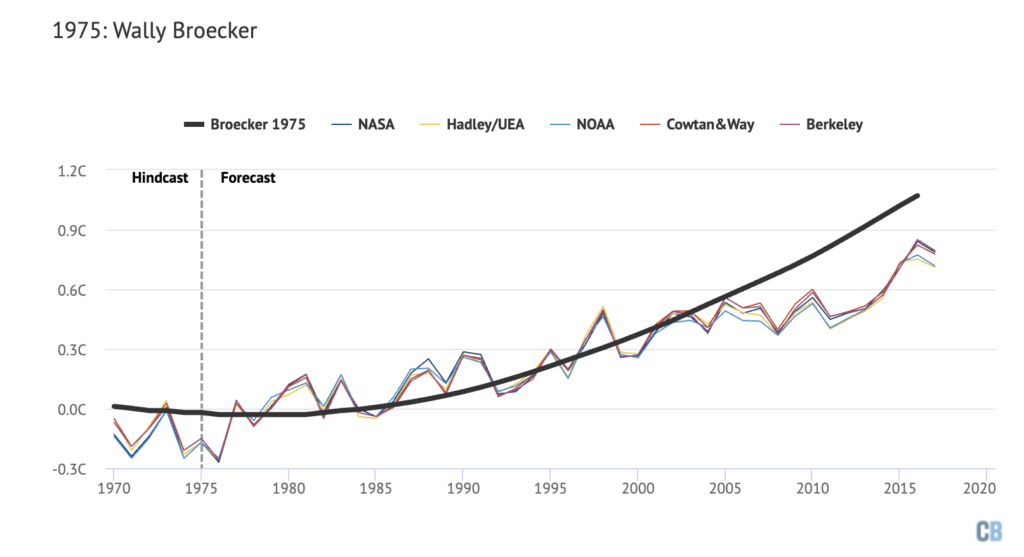
Broecker made his projection at a time when scientists widely thought that the observations showed a modest cooling of the Earth. He began his article past presciently stating that "a strong case can be made that the nowadays cooling trend will, inside a decade or so, give way to a pronounced warming induced past carbon dioxide".
Hansen et al, 1981
NASA's Dr James Hansen and colleagues published a paper in 1981 that as well used a simple energy residual model to projection time to come warming, but accounted for thermal inertia due to ocean heat uptake. They assumed a climate sensitivity of 2.8C per doubling CO2, but also looked at a range of 1.four-5.6C per doubling.
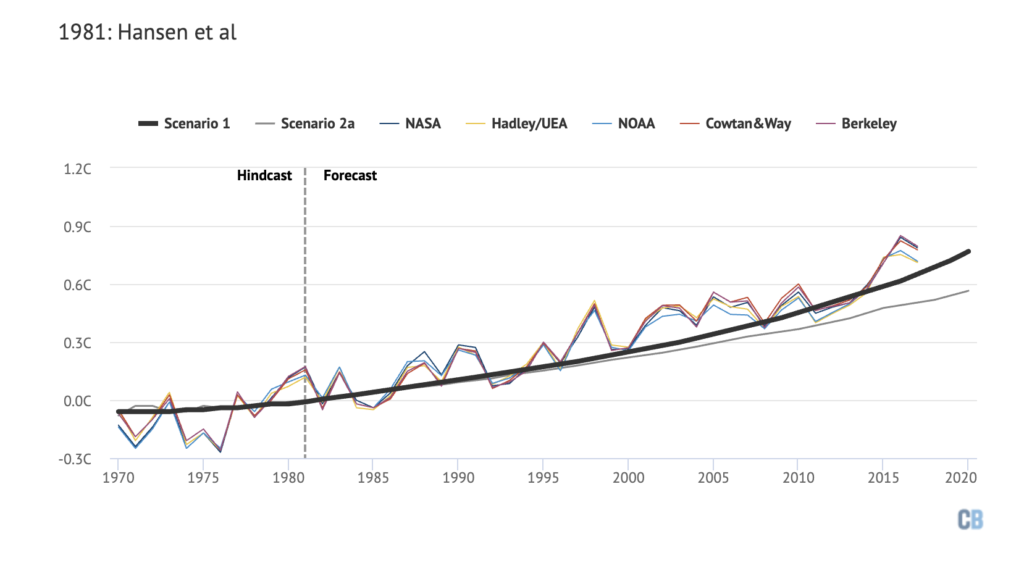
Hansen and colleagues presented a number of different scenarios, varying future emissions and climate sensitivity. In the chart above, you tin can encounter both the "fast-growth" scenario (thick black line), where CO2 emissions increment past 4% annually later 1981, and a ho-hum-growth scenario where emissions increase past ii% annually (thin grey line). The fast-growth scenario somewhat overestimates current emissions, but when combined with a slightly lower climate sensitivity information technology provides an estimate of early on-2000s warming close to observed values.
The overall charge per unit of warming betwixt 1970 and 2016 projected by Hansen et al in 1981 in the fast-growth scenario has been about 20% lower than observations.
Hansen et al, 1988
The paper published by Hansen and colleagues in 1988 represented ane of the offset mod climate models. It divided the world into discrete grid cells of eight degrees breadth past 10 degrees longitude, with nine vertical layers of the atmosphere. It included aerosols, various greenhouse gases in addition to CO2, and basic cloud dynamics.
Hansen et al presented three different scenarios associated with different futurity greenhouse gas emissions. Scenario B is shown in the chart below as a thick blackness line, while scenarios A and C are shown past thin gray lines. Scenario A had exponential growth in emissions, with CO2 and other GHG concentrations considerably higher than today.
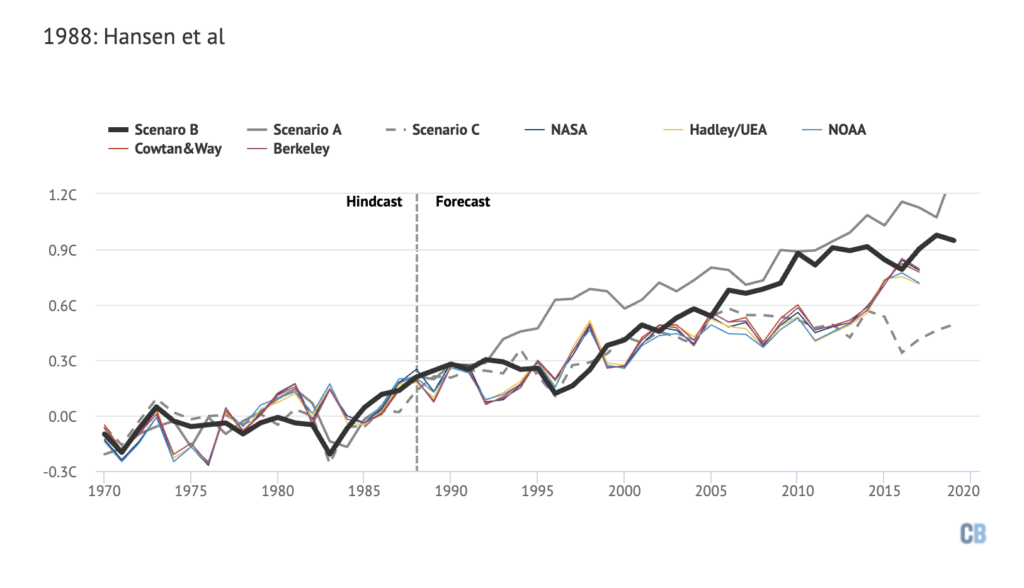
Scenario B assumed a gradual slowdown in CO2 emissions, but had concentrations of 401ppm in 2016 that were pretty close to the 404ppm observed. However, scenario B assumed the continued growth of emissions of various halocarbons that are powerful greenhouse gases, but were subsequently restricted under the Montreal Protocol of 1987. Scenario C had emissions going to near-nothing after the twelvemonth 2000.
Of the 3, scenario B was closest to actual radiative forcing, though still about 10% too loftier. Hansen et al too used a model with a climate sensitivity of 4.2C per doubling CO2 – on the high end of most modern climate models. Due to the combination of these factors, scenario B projected a charge per unit of warming between 1970 and 2016 that was approximately 30% higher than what has been observed.
IPCC Get-go Cess Study, 1990
The IPCC'due south Kickoff Assessment Report (FAR) in 1990 featured relatively simple energy remainder/upwelling diffusion body of water models to gauge changes in global air temperatures. Their featured business-as-usual (BAU) scenario causeless rapid growth of atmospheric CO2, reaching 418ppm CO2 in 2016, compared to 404ppm in observations. The FAR besides causeless continued growth of atmospheric halocarbon concentrations much faster than has really occurred.
The FAR gave a best estimate of climate sensitivity every bit 2.5C warming for doubled CO2, with a range of i.5-four.5C. These estimates are applied to the BAU scenario in the effigy below, with the thick black line representing the best approximate and the thin dashed black lines representing the high and low stop of the climate sensitivity range.
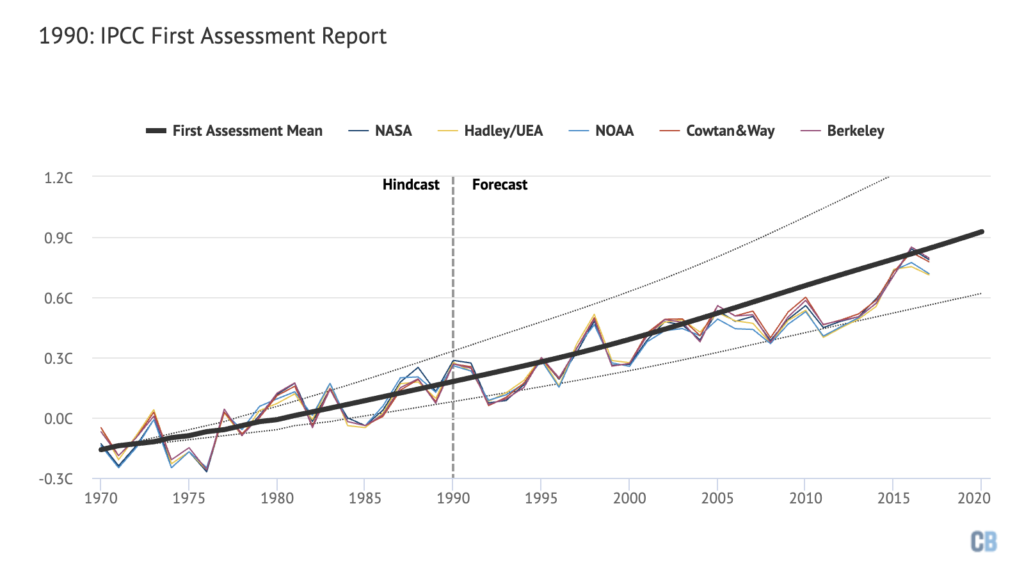
Despite a best guess of climate sensitivity a tad lower than the 3C used today, the FAR overestimated the rate of warming between 1970 and 2016 by around 17% in their BAU scenario, showing 1C warming over that menstruation vs 0.85C observed. This is mostly due to the project of much higher atmospheric CO2 concentrations than has actually occurred.
IPCC Second Assessment Written report, 1995
The IPCC's Second Assessment Report (SAR) only published readily-bachelor projections from 1990 onward. They used a climate sensitivity of ii.5C, with a range of 1.v-4.5C. Their mid-range emissions scenario, "IS92a", projected CO2 levels of 405ppm in 2016, about identical to observed concentrations. SAR also included much meliorate treatment of anthropogenic aerosols, which have a cooling outcome on the climate.
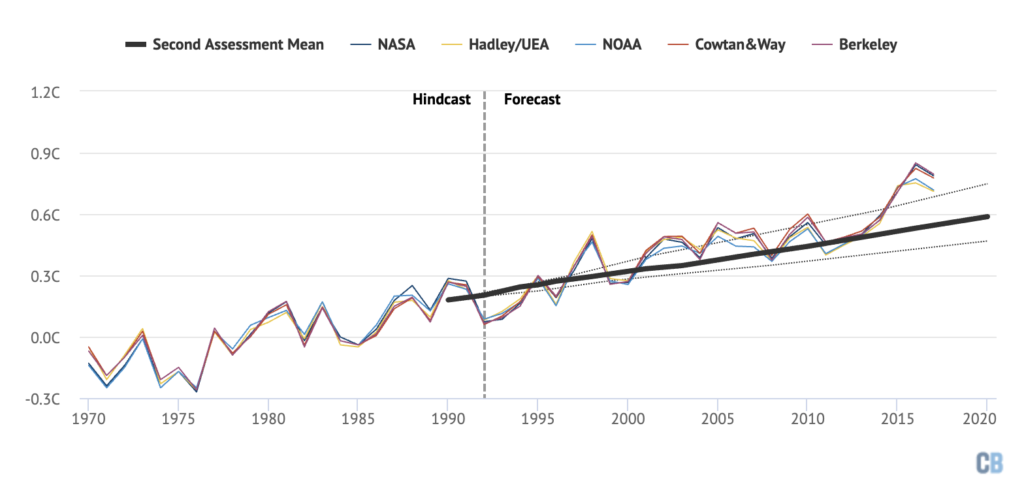
Equally you lot can meet in the chart to a higher place, SAR'south projections ended upwards being notably lower than observations, warming about 28% more slowly over the period from 1990 to 2016. This was likely due to a combination of two factors: a lower climate sensitivity than institute in mod estimates (2.5C vs. 3C) and an overestimate of the radiative forcing of CO2 (four.37 watts per foursquare meter versus iii.7 used in the subsequent IPCC report and however used today).
IPCC Third Assessment Report, 2001
The IPCC 3rd Cess Report (TAR) relied on atmosphere-sea general circulation models (GCMs) from seven different modeling groups. They likewise introduced a new gear up of socioeconomic emission scenarios, chosen SRES, which included 4 unlike future emission trajectories.
Hither, Carbon Cursory examines the A2 scenario, though all have fairly similar emissions and warming trajectories upward to 2020. The A2 scenario projected a 2016 atmospheric CO2 concentration of 406 ppm, well-nigh the aforementioned as what was observed. The SRES scenarios were from 2000 onward, with models prior to the year 2000 using estimated historical forcings. The dashed grey line in the effigy above shows the point at which models transition from using observed emissions and concentrations to projected future ones.
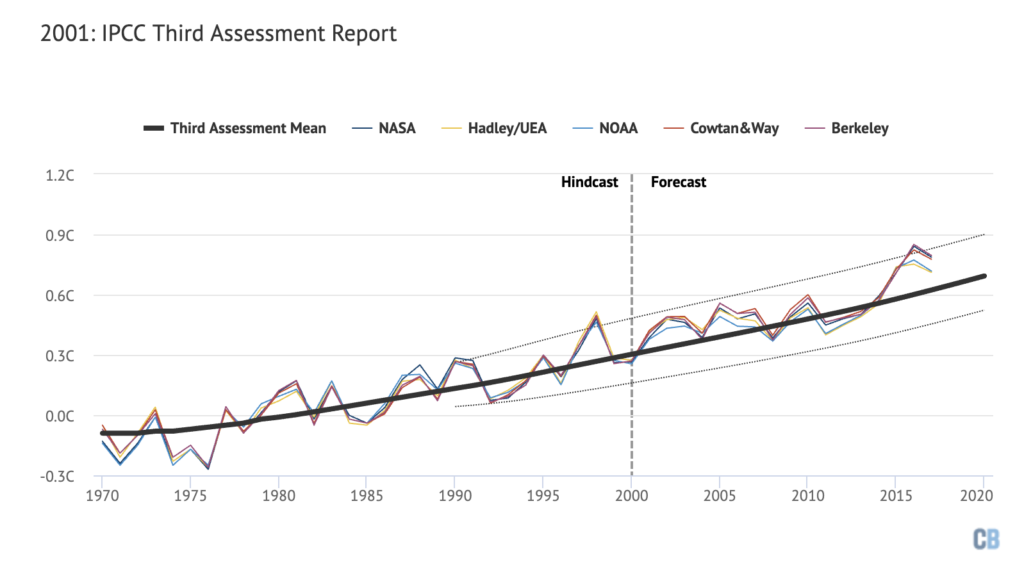
TAR'due south headline project used a simple climate model that was configured to match the boilerplate outputs of seven more sophisticated GCMs, equally no specific multimodel boilerplate was published in TAR and data for individual model runs are not readily bachelor. It has a climate sensitivity of 2.8C per doubling CO2, with a range of 1.5-4.5C. As shown in the chart above, the rate of warming between 1970 and 2016 in the TAR was about 14% lower than what has actually been observed.
IPCC Fourth Assessment Report, 2007
The IPCC's Fourth Assessment Study (AR4) featured models with significantly improved atmospheric dynamics and model resolution. Information technology made greater use of World System Models – which incorporate the biogeochemistry of carbon cycles – equally well as improved simulations of land surface and water ice processes.
AR4 used the same SRES scenarios as the TAR, with historical emissions and atmospheric concentrations upwardly to the twelvemonth 2000 and projections thereafter. Models used in AR4 had a mean climate sensitivity of iii.26C, with a range of ii.1C to 4.4C.
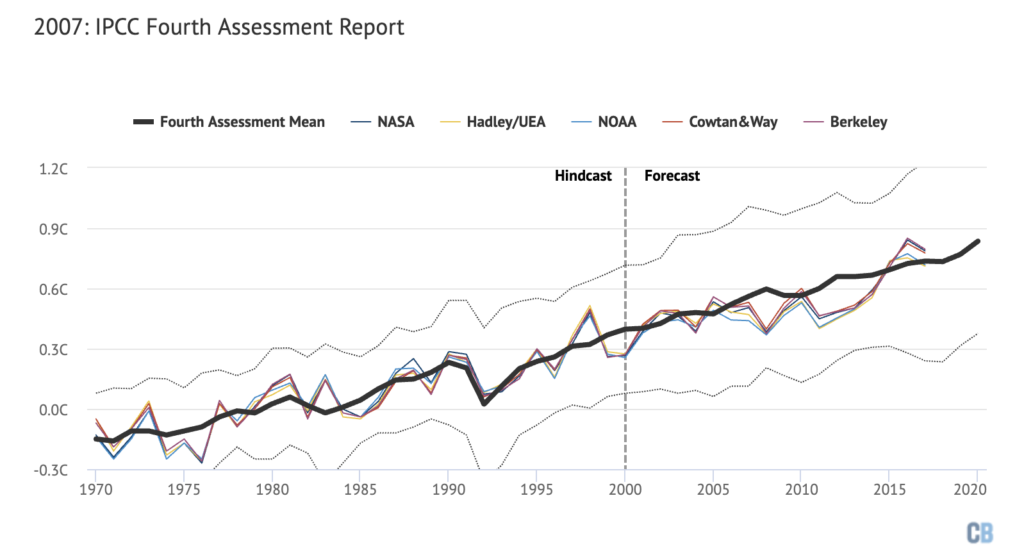
The effigy to a higher place shows model runs for the A1B scenario (which is the just scenario with model runs readily available, though its 2016 CO2 concentrations are nearly identical to those of the A2 scenario). AR4 projections between 1970 and 2016 bear witness warming quite close to observations, only 8% higher.
IPCC 5th Cess Report, 2013
The nearly contempo IPCC study – the Fifth Cess (AR5) – featured additional refinements on climate models, as well as a modest reduction in future model uncertainty compared to AR4. The climate models in the latest IPCC written report were part of the Coupled Model Intercomparison Project 5 (CMIP5), where dozens of different modeling groups all effectually the world ran climate models using the same set up of inputs and scenarios.
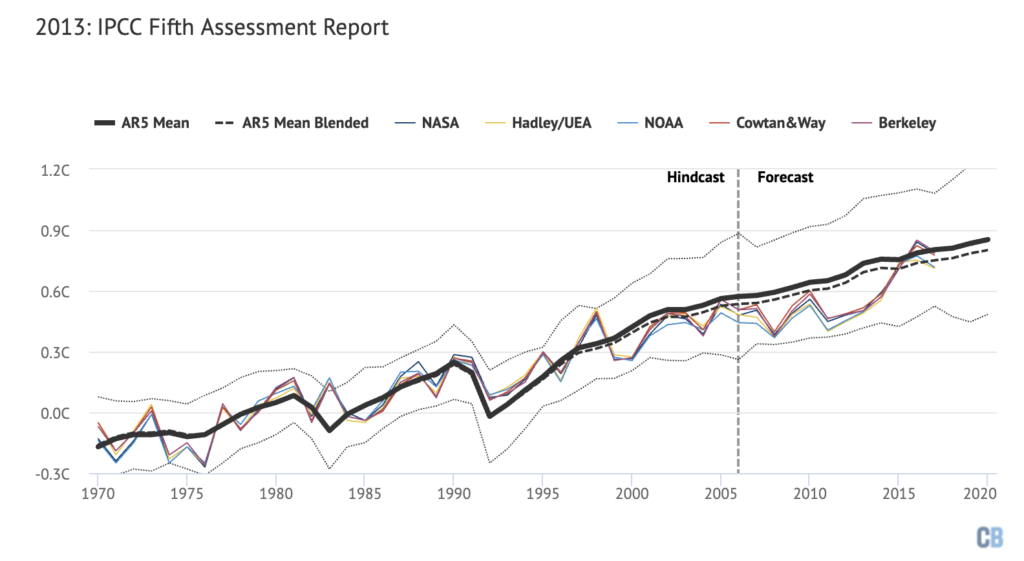
AR5 introduced a new fix of future greenhouse gas concentration scenarios, known every bit the Representative Concentration Pathways (RCPs). These have future projections from 2006 onwards, with historical data prior to 2006. The grey dashed line in the figure above shows where models transition from using observed forcings to projected future forcings.
Comparing these models with observations tin be a somewhat tricky exercise. The most often used fields from climate models are global surface air temperatures. However, observed temperatures come from surface air temperatures over land and ocean surface temperatures over the ocean.
To account for this, more recently, researchers have created blended model fields, which include sea surface temperatures over the oceans and surface air temperatures over land, in order to friction match what is actually measured in the observations. These composite fields, shown by the dashed line in the figure to a higher place, prove slightly less warming than global surface air temperatures, as models have the air over the body of water warming faster than sea surface temperatures in contempo years.
Global surface air temperatures in CMIP5 models take warmed well-nigh xvi% faster than observations since 1970. About xl% of this deviation is due to air temperatures over the ocean warming faster than sea surface temperatures in the models; composite model fields only bear witness warming 9% faster than observations.
A recent paper in Nature past Iselin Medhaug and colleagues suggests that the remainder of the divergence tin can be accounted for by a combination of short-term natural variability (mainly in the Pacific Body of water), small volcanoes and lower-than-expected solar output that was non included in models in their post-2005 projections.
Below is a summary of all the models Carbon Brief has looked at. The table below shows the difference in the rate of warming between each model or set of models and NASA'south temperature observations. All the observational temperature records are fairly similar, merely NASA's is among the group that includes more complete global coverage in contempo years and is thus more straight comparable to climate model data.
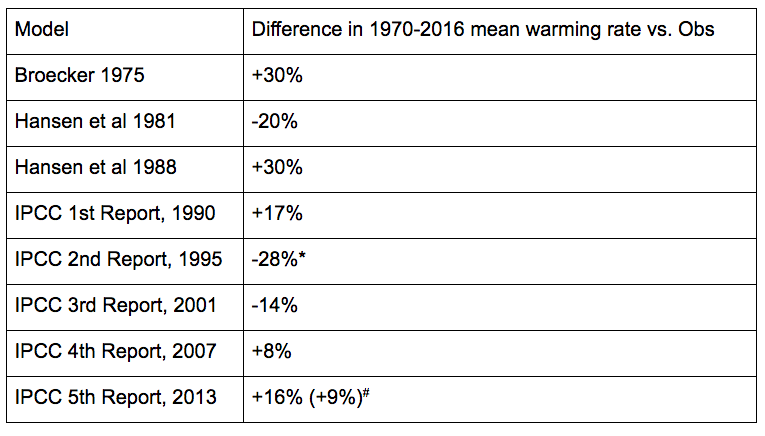
# Differences in parenthesis based on blended model land/bounding main fields
Determination
Climate models published since 1973 have more often than not been quite skilful in projecting future warming. While some were too depression and some too high, they all show outcomes reasonably close to what has actually occurred, especially when discrepancies between predicted and actual CO2 concentrations and other climate forcings are taken into account.
Models are far from perfect and will continue to be improved over time. They also show a fairly large range of future warming that cannot easily be narrowed using just the changes in climate that nosotros have observed.
Even so, the close match between projected and observed warming since 1970 suggests that estimates of hereafter warming may testify similarly accurate.
Methodological note
Environmental scientist Dana Nuccitelli helpfully provided a list of past model/observation comparisons, available here. The PlotDigitizer software was used to obtain values from older figures when data was non otherwise available. CMIP3 and CMIP5 model data was obtained from KNMI Climate Explorer.
Animation by Rosamund Pearce.
delatorreacqualatithe.blogspot.com
Source: https://www.carbonbrief.org/analysis-how-well-have-climate-models-projected-global-warming
0 Response to "Dire Predictions of Global Warming Dating Back to 1987 Have Been Wrong Again and Again."
Post a Comment